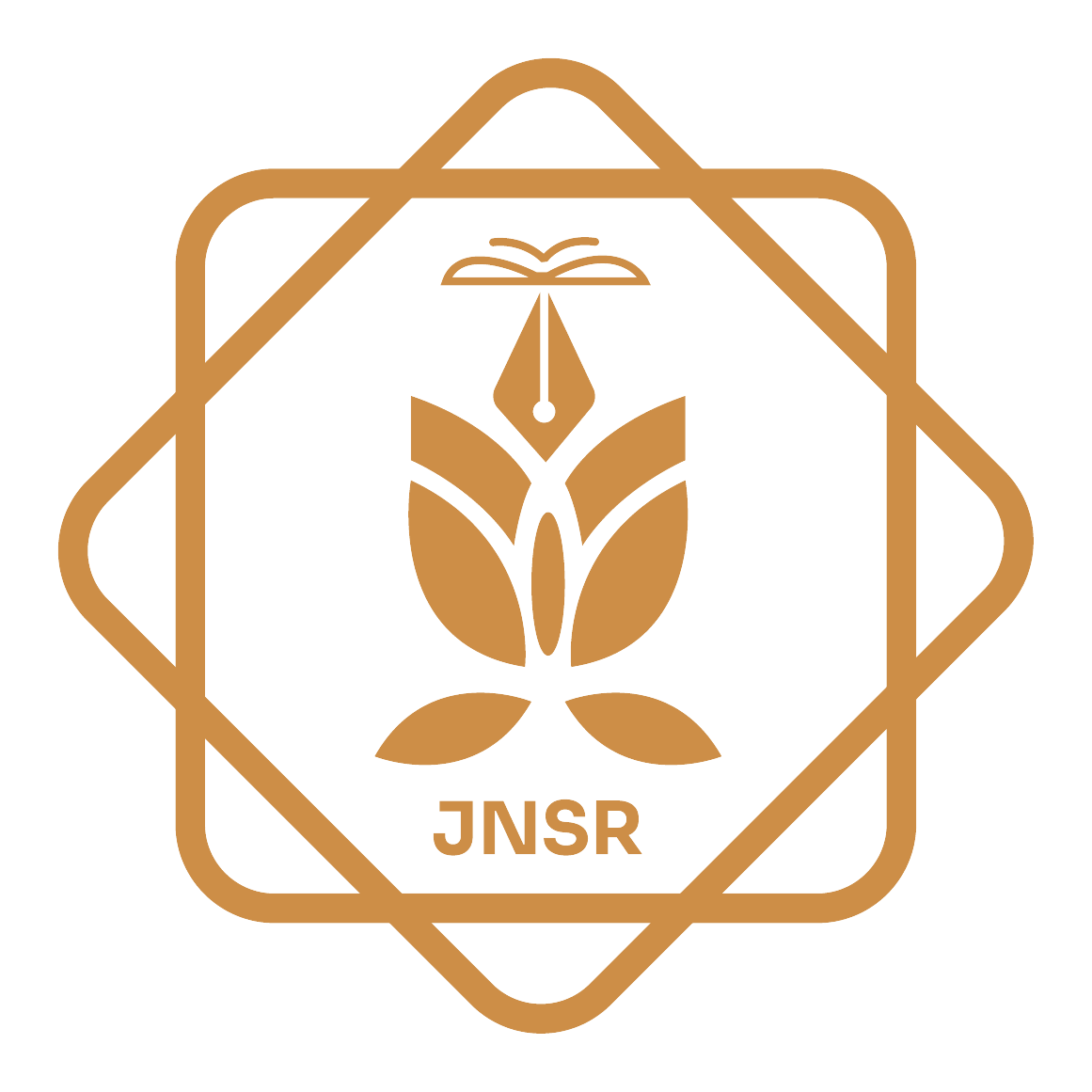Determination of Phenolic and Flavonoid Content in Ziziphus Jujuba Mill. Fruit Collected from Farah Province, Afghanistan
DOI:
https://doi.org/10.62810/jnsr.v2i1.27Keywords:
Flavonoid Content, Exported edible and medicinal Plants, Jujube, Phenolics, StandardizationAbstract
The fruit of jujube (Ziziphus jujuba Mill.), a member of the Rhamnaceous family, is a valuable exporting dry fruit of Afghanistan. The plant is found in some provinces of the country, but Farah province produces it more. The purposes of this study were to standardize the jujube fruit collected from Farah Province and to determine the amount of its phenolic and flavonoid contents. Jujube fruit (JFs22) was collected from medicinal plant sellers in Kabul. After identification and pharmacogenetic evaluation of JFs22, the amount of phenolic and flavonoid content in the fruit was determined using UV-Vis spectroscopy. The test sample was Ziziphus jujuba. The JFs22 had 10.27±0.532% foreign matter, 4.58±0.33% moisture, 1.97±0.09% total ash, 0.26±0.04% acid insoluble ash, 50.69±0.30% water soluble extractive content, and 24.93±0.59% methanolic extractive value. The JFs22 had flavonoids, alkaloids, tannins, phenolic substances, saponin, and mucilage as its active ingredients. The total phenolic (TPC) and total flavonoid (TFC) contents of the methanolic extract of JFs22 were 9.84±1.65 mg gallic acid equivalent (GAE) and 0.55±0.04 mg rutin equivalent (RE) in 3 grams of dry fruit weight, respectively. Although in most of the cases, the values obtained from the pharmacogenetic evaluation of JFs22 were lower than the standard, nevertheless, they are within the standard range available in pharmacopeias, and this may be considered a good quality of tested jujube fruit and notice for paying much attention for its processing. The determination of TPC and TFC of JFs22 showed that the Farah province jujube fruit has many polyphenols.
Downloads
References
Ahmed, H. M. (2016). Ethnopharmacobotanical study on the medicinal plants used by herbalists in Sulaymaniyah Province, Kurdistan, Iraq. J Ethnobiol Ethnomed., 12(8). doi: 10.1186/s13002-016-0081-3. DOI: https://doi.org/10.1186/s13002-016-0081-3
Azizi, A., & Pirbodaghi , M. (2016). Regional variations of antioxidant capacity and phenolic properties in the Iranian jujube collection. Journal of Herbal Drugs, 8(4), 199-209.
Bai, L., Zhang, H., Liu, Q., Zhao, Y., Cui, X., Guo, S., et al. (2015). Chemical Characterization of the Main Bioactive Constituents from Fruits of Ziziphus Jujuba. Food & Function, 3-23. doi: 10.1039/c6fo00613b. DOI: https://doi.org/10.1039/C6FO00613B
Breckle, S. -W., & Rafiqpoor, M. D. (2013). Vascular plants of Afghanistan an Augmented Checkist (Vol. 6). (A. Dittmann, Ed.) Bonn: The Deutsche Nationalbibiothek.
Chen, J., & Tsim, K. W. (2020). A Review of Edible Jujube, the Ziziphus Jujuba Fruit: A Heath Food Supplement for Anemia Prevalence. Front Pharmacol, 11, 593655. Doi: 10.3389/fphar.2020.593655. DOI: https://doi.org/10.3389/fphar.2020.593655
Chen, J., Li, Z., Maiwulanjiang, M., Zhang, W. L., & Zhan, J. Y. (2013). Chemical and Biological Assessment of Ziziphus Jujuba Fruit from China. Agricultural and Food Chemistry, 61, 7315-7316. doi: 10.1021/jf402379u. DOI: https://doi.org/10.1021/jf402379u
Choi, S.-H., Ahn, J.-B., Kozukue, N., Levin, C. E., & Friedman, M. (2011). Distribution of Free Amino Acids, Flavonoids, Total Phenolics, and Antioxidative Activities of Jujube (Ziziphus Jujuba) Fruits and Seeds Harvested from Plants Grown in Korea. J. Agric. Food Chem., 59(12), 6594–6604. doi: 10.1021/jf200371r. DOI: https://doi.org/10.1021/jf200371r
Cosmulescu, S., TRANDAFIR, I., Nour, V., & Achim, G. (2017). Variation of Bioactive Compounds and Antioxidant Activity of Jujube (Ziziphus jujuba) Fruits at Different Stages of Ripening. Notulae Botanicae Horti Agrobotanici Cluj-Napoca, 46(1), 134. https://doi.org/10.15835/nbha46110752 DOI: https://doi.org/10.15835/nbha46110752
Dehkordi, N. G. (2003). Iranian Herbal Pharmacopoeia (Vol. 2). Tehran: Ministry of Health, Medicine, and Education Deputy Food and Drug.
Delfanian, M., Kenari, R. E., & Sahari, M. A. (2016). Utilization of Jujube Fruit (Ziziphus mauritiana Lam.) Extracts as Natural Antioxidants in Stability of Frying Oil. International Journal of Food Properties, 19, 789–801. https://doi.org/10.1080/10942912.2015.1043638 DOI: https://doi.org/10.1080/10942912.2015.1043638
Ersoy, N., Kupe, M., Sagbas, H. I., & Eecisli, S. (2018). Physicochemical Diversity Amonge Barbery (Berberis vulgaris L.) Fruits from Eastern Anatolia. AcademicPres, 46(2), 336-342. https://doi.org/10.15835/nbha46211111 DOI: https://doi.org/10.15835/nbha46211111
Ghani, A., Amini, S., Mohtashami, S., & Neamati, S. H. (2022). Physicochemical and biochemical variations of jujube (Ziziphus jujuba Mill.) populations: A comparison of Iranian and imported types. Industrial Crops and Products, 183, 114898. https://doi.org/10.1016/j.indcrop.2022.114898 DOI: https://doi.org/10.1016/j.indcrop.2022.114898
Ghobadi, A., Amini-Behbahani, F., Yousefi, A., Shirazi, M. T., & Behnoud, N. (2019). Medicinal and Nutritional Properties of Ziziphus Jujuba Mill. in Traditional Persian Medicine and Modern Phytotherapy. Crescent Journal of Medical and Biological Sciences, 6(2), 146-150.
Jalil, I. M., Jaiswara, S., Farooqui, A., Riyaz, A., & Chinchulkar, G. (2021). Investigations on Ziziphus Jujuba for Pharmacognostical and Anthelmintic Activity -- A Pilot Study. Journal of Emerging Technologies and Innovative Research, 8(11), c596- c609.
Ji, X., Peng, Q., Yuan, Y., Shen, J., Xie, X., & Wang, M. (2017). Isolation, structures, and bioactivities of the polysaccharides from jujube fruit. Food Chemistry, 74(1), 4-6. doi 10.1016/j.foodchem.2017.01.074.
Kamiloglu, O., Ercisli, S., Engül, M., Toplu, C., & Serce, S. (2009). Total phenolics and antioxidant activity of jujube (Zizyphus jujube Mill.) Genotypes selected from Turkey. AFRICAN JOURNAL OF BIOTECHNOLOGY, 8(2), 303-307.
Khadivi, A., & Beigi, F. (2022). Morphological and chemical characterizations of jujube (Ziziphus Jujuba Mill.) to select superior accessions. Food Sci Nutr, 10, 2213–2223. doi: 10.1002/fsn3.2831. DOI: https://doi.org/10.1002/fsn3.2831
Pareek, S. (2013). Nutritional composition of jujube fruit. Emirates Journal of Food and Agriculture, 25(8). doi: 10.9755/ejfa.v2516.15552 DOI: https://doi.org/10.9755/ejfa.v25i6.15552
Rashwan, A. K., Karim, N., Shishir, M. R., & Lu, Y. (2020). Jujube fruit: A potential nutritious fruit for developing functional food products. Journal of Functional Foods, 75(9), 104205. https://doi.org/10.1016/j.jff.2020.104205 DOI: https://doi.org/10.1016/j.jff.2020.104205
Rechinger, K. (1977). Plants of the Touran protected area. Iranian Journal of Botany, 1, 155–180.
Shraim, A. M., Ahmed, T., Rahman, m. M., & Hijji, Y. (2021). Determination of total flavonoid content by aluminum chloride assay: A critical evaluation. LWT, 150(2), 111932. https://doi.org/10.1016/j.lwt.2021.111932 DOI: https://doi.org/10.1016/j.lwt.2021.111932
Sweety, C. B., Ravindra , J. S., & Dattaprasad , V. N. (2022). A Review on Zizyphus jujube: A Tiny Plum having Eminent Potential of Copious Health Benefits. Research Journal of Pharmacognosy and Phytochemistry, 14(2), 107- 112.doi:10.52711/0975-4385.2022.00020 DOI: https://doi.org/10.52711/0975-4385.2022.00020
Tepe, F. B., Ekinci, R., Kadakal, Ç., & Nizamlıoğlu, N. M. (2022). A Review: The Physical, Nutritional, Bioactive Properties and Health. Celal Bayar University Journal of Science, 18(1), 67-75. doi: 10.18466/cbayarfbe.913267 DOI: https://doi.org/10.18466/cbayarfbe.913267
Vafaei, F., & Abdollahzadeh, F. (2015). Investigating the effects of Hydroalcoholic jujube fruit extract (Zizyphus vulgaris L.) on healing second-degree burn wounds in Balb/c mice. J Med Life., 8(Spec Iss 2), 117–120.
Xie, P.-j., You, F., Huang, L.-x., & Zhang, C.-h. (2017). Comprehensive assessment of phenolic compounds and antioxidant performance in the developmental process of jujube (Ziziphus jujuba Mill.). Journal of Functional Foods, 17, 233-242. https://doi.org/10.1016/j.jff.2017.07.012 DOI: https://doi.org/10.1016/j.jff.2017.07.012
Xue, X., Zhao, A., Wang, Y., Ren, H., Du, J., Li, D., et al. (2021). Composition and content of phenolic acids and flavonoids among the different varieties, development stages, and tissues of Chinese Jujube (Ziziphus jujuba Mill.). PLoSONE, 16(10), e0254058. Doi: 10.1371/journal.pone.0254058 DOI: https://doi.org/10.1371/journal.pone.0254058
Zhang, Q., Wang, L., Wang, Z., Liu, Z., Zhao, Z., Zhou, G., et al. (2020). Variations of the nutritional composition of jujube fruit (Ziziphus jujuba Mill.) during maturation stages. International Journal of Food Properties, 23(1), 1066-1081. https://doi.org/10.1080/10942912.2020.1770281 DOI: https://doi.org/10.1080/10942912.2020.1770281
Downloads
Published
How to Cite
Issue
Section
License
Copyright (c) 2024 Rabia Ayoubi, Mohammad Musa Foladi, Salma Lutfi, Aqa Mohammad Zhakfar

This work is licensed under a Creative Commons Attribution-NonCommercial 4.0 International License.



























